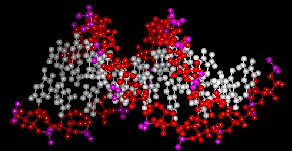| Home |
| Introduction |
| Need for Medicinal GMOs |
| Economics |
| Methods |
| Types of Medicinal GMOs |
| Ethical Issues |
| World Opinions |
| References |
Permission pending from http://www.apsnet.org/online |
Introduction |
Permission pending from http://www.niaes.affrc.go.jp/annual |
_________________________________________________
Through-out history, medicines of some form have been essential to protect humans against both viral and bacterial diseases. With the rise of the 20th century, medicines have become much more sophisticated, first with the discovery of penicillin and other naturally occurring drugs. Recent scientific advances, for example complex laboratories, pharmaceutical companies began to create new molecular compounds able to ward off diseases. However, with the current trend of drug resistance among disease inducing viruses and bacteria, the need for another kind of antimicrobial has arisen. This new means of fighting diseases is through genetic modification.
Genetic modification is the alteration of an organism's genetic makeup by introducing another organism's genes into the original organisms DNA (Genetic Modification, 2004). In past two decades, genetically modified organisms have been created using bacteria, plants, fungi and animals. One use of this new technology is to insert a certain gene into an organism so that the organism will produce an enzyme or protein or even antibiotic that can be used in medicine. These medicinal uses of genetically modified organisms might eventually be the way that humans are able to produce mass amounts of antibiotics and proteins needed to fight the ever growing problem of antibiotic bacteria and nutrition deficiency of developing countries.
In recent years, numerous advances in health treatment methods have led to a rapid rise in the number of medicinal products on the market. As a result, the demand for the therapeutic proteins, which serve as the foundation for these products, has increased as well (Larrick, 2001). Traditional methods for the production of these proteins have also suffered because they can no longer keep up with the rapid pace of drug demand. This disparity has forced pharmaceutical companies to develop alternative means for therapeutic protein production. Their search has led them to the field of transgenic organisms.
Example of Medicinal GMOs: GM Cows
Transgenic animals are a promising solution to the large-scale production of therapeutic proteins because they can be modified to express a specific protein into a frequently occurring biological process, such as milk production (Wells, 2003). The most commonly used traditional method of protein production involves bacterial culture, which produces moderate amounts of protein in a less than efficient manner. In contrast, herds of transgenic cows, which have been modified to express a protein in their mammary glands, can churn out gallons of protein rich milk more efficiently for a longer period of time.
The greatest problem with the immediate and complete transition from traditional methods to their transgenic alternatives lies in the fact that it is initially difficult to establish a founder population of a given transgenic animal (Larrick, 2001). Researchers are faced with the difficulty of identifying high yield animals and then producing large amounts of this caliber animal either sexually or synthetically. The fact that the demand for large amounts of therapeutic protein has not diminished ensures that continued research and development with transgenic animals will eventually permit the transition.
____________________________________________________
_____________________________________________________
This web page was produced as an assignment for an undergraduate course at Davidson College.
©Copyright 2004 Department of Biology, Davidson College,
Davidson, NC 28035
Send comments, questions, and suggestions to William Wood at wiwood(at)davidson.edu

